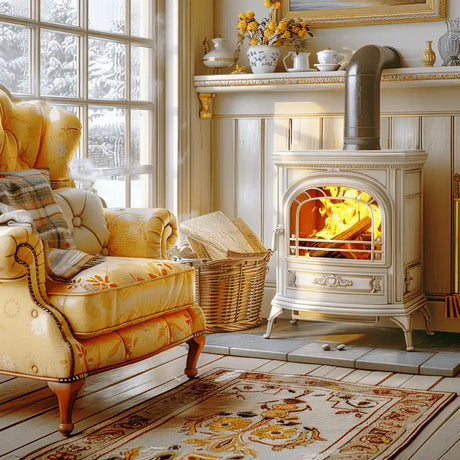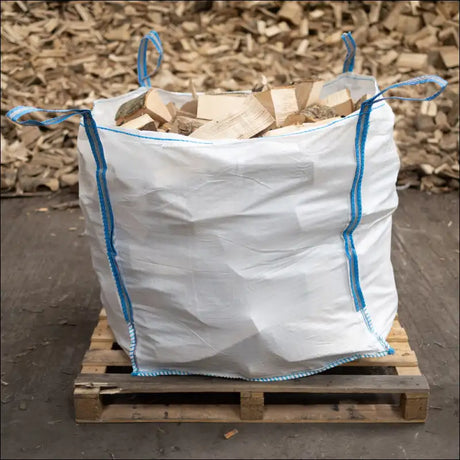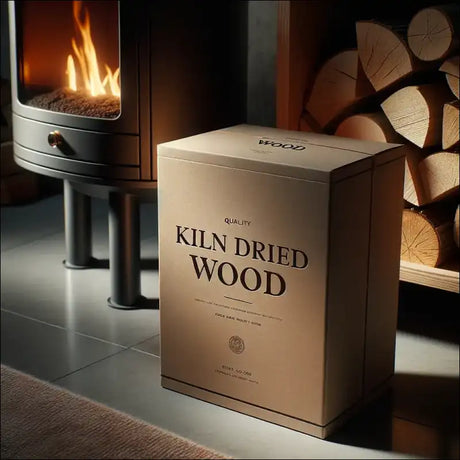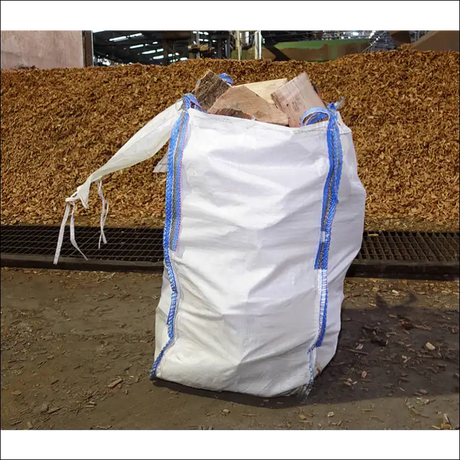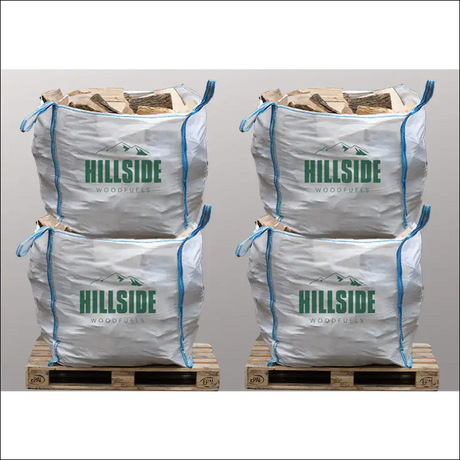| Section | Key Points |
|---|---|
| Hardwoods vs Softwoods | - Hardwoods burn slower, give more heat, less creosote. - Softwoods cheaper, light fast, burn hot. |
| Kiln-Dried vs Green Logs | - Kiln-dried more efficient, heat, quick lighting. - Green logs cheaper but problems like creosote. |
| Log Size | - Match log size to stove firebox. - Small stoves need short, small logs. - Big stoves suit long, thick logs. |
| Log Density | - Dense hardwoods give most heat. - Oak, beech, ash have top heat value. |
| Moisture Content | - Keep logs dry right until burning. - Wet wood causes problems. |
| Sustainably Sourced | - Buy from sustainable forestry sources. - Local logs have lower transport miles. |
| Buy Seasoned Wood | - Avoid fresh 'green' logs. - Well seasoned wood has cracks, dark color. |
| Hardwood/Softwood Blends | - Blends give best of both worlds. - Balance of burn speeds, heat, cost. |
| Top Species To Try | - Oak, beech, ash, birch, pine. |
| Avoid Problem Woods | - Elm, eucalyptus, willow, poplar. |
| Premium Kiln-Dried | - Ultimate performance logs. - 50% more heat, instant lighting. |
| Conclusion | - Select log type for needs. - Match size to stove. - Kiln dried for efficiency. |
Selecting the perfect logs for your wood burner is key to getting the most out of your fireplace. With so many options available, from hardwoods to softwoods, kiln-dried to green, it can be confusing to know which logs are best suited for your needs. In this comprehensive guide, we’ll walk through the key factors to consider when choosing firewood, from burn time and heat output to moisture content and emissions. Read on for pro tips to help you pick the ideal logs for your wood burner.
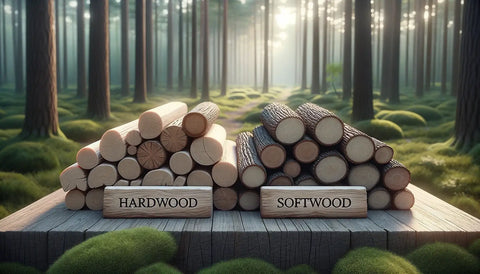
Hardwoods vs. Softwoods
The first decision to make is whether you want to burn hardwood or softwood logs. Hardwoods like oak, ash, and beech are denser and heavier than softwoods such as pine and spruce. This density means hardwoods:
- Burn slower and longer - A load of hardwood logs will provide a steady, long-lasting fire compared to softwoods. Hardwoods are perfect for overnight burning.
- Give more heat output - The dense structure of hardwoods produces more BTUs (British Thermal Units) when burned. Hardwoods release around 15-20 million BTUs per cord compared to 9-15 million BTUs for softwoods.
- Create less creosote - Hardwoods tend to burn cleaner and leave behind less creosote residue in your chimney. Less creosote buildup means lower risk of chimney fires.
- Have less sap - Softwoods like pine contain sticky resins and sap that can build up in your flue lining over time. Hardwoods burn cleaner without excess sap.
However, softwoods do have some advantages:
-
Cost less - Softwood logs are typically cheaper to buy than hardwoods. This makes them a budget-friendly option.
- Light quickly - The high resin content means softwood logs easily catch fire and light up fast. Softwoods are great for quick warmth.
- Burn hot - The quick, hot burn of softwoods makes them perfect for tasks like cooking over a fire. The high flame temperature is ideal for grilling.
So in summary, while softwoods have their uses, hardwoods are generally the best choice for wood burners due to their steady, long-lasting heat and clean burn.
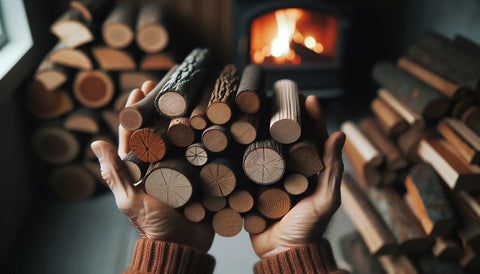
Kiln-Dried vs. Green Logs
Once you’ve decided between hardwood and softwood, the next factor to consider is moisture content. Firewood is either ‘green’ (freshly cut logs with a high moisture content) or ‘kiln-dried’ (heat-treated to remove moisture).
Kiln-drying has many advantages:
- Burns more efficiently - With less water content, more of the energy released goes into heating your room rather than boiling off moisture.
- Produces more heat - Dry wood has a higher calorific value, giving up to 25% more usable heat compared to green logs.
- Lights quickly - Without moisture to hamper ignition, kiln-dried logs easily catch light and get your fire going fast.
- Burns cleaner - Drying wood reduces creosote buildup in your chimney by up to 25%. Less dirt means safer, more efficient burning.
- Less smoke - With moisture expelled during kilning, kiln-dried logs make much less smoke when burned.
- Fewer embers and ashes - Drier logs produce less charred residue after burning. Less ash makes cleaning out your stove easier.
- Less chance of insects - Drying eliminates pests like woodworm that can infest damp logs. No bugs or eggs means cleaner, safer wood fuel.
- Can burn immediately - Freshly cut green wood needs seasoning before use while kiln-dried logs can burn straight away.
While kiln-drying comes with a small price premium, the extra efficiency, heat and convenience make it worthwhile for most wood stove owners.

Log Size
When selecting firewood, you’ll also need to consider the size of the logs. This depends on the model of your stove and its firebox dimensions. As a general guide:
- Smaller wood burners - For compact stoves, opt for short logs around 20-25cm long. Small-diameter split logs 10-15cm across are also ideal.
- Medium-sized stoves - Popular mid-range models do well with logs around 30-40cm long and up to 20cm diameter.
- Large stoves and cookers - Big fireboxes can handle large logs up to 50cm long and 25cm diameter. Whole unsplit logs also work for extra long burn times.
Ideally, your logs should be 2-3cm shorter than your firebox so you can place them in easily. Always check the manual for your specific stove’s log size guidelines.
The shape of your logs also matters - avoiding overly-round logs which can roll and choosing evenly-split logs that pack together snugly is best for efficient burning.
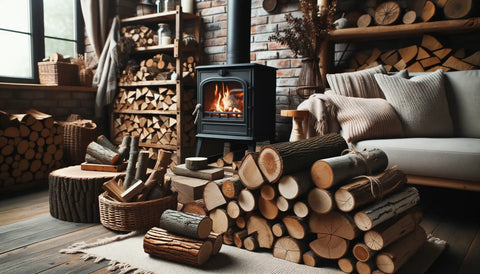
Log Density
As we learned earlier, dense hardwoods produce more heat energy than softwoods when burned. But even among hardwood logs, some species are denser and therefore give better heat output.
The greatest heat comes from very dense hardwoods like oak, beech and ash. Moderately dense hardwoods like birch, elm and hornbeam are mid-range. Soft hardwoods like willow, poplar and lime produce less heat.
Coniferous softwoods have the lowest density and heat output, with pine and spruce at the bottom of the scale.
So if heating power is a priority, choose logs from dense hardwood trees to get the most bang from your firewood. Species like oak, beech and ash give the biggest heat punch per log.
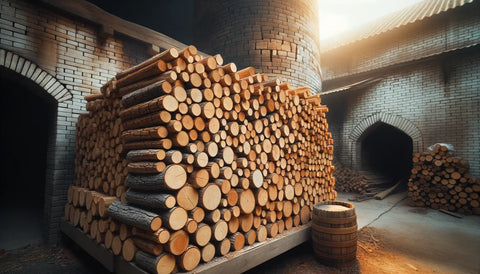
Moisture Content
We’ve already covered the importance of burning dry kiln-dried wood for efficiency. But it’s also vital to keep your logs dry in storage and handling. Wet or rain-soaked logs won’t burn well and may harm your chimney.
Kiln-drying takes wood down to a moisture content of around 20%. To keep it this dry:
- Store logs off the ground on pallets or rails to avoid dampness.
- Keep them under cover and protected from rain and snow. A wood store, woodshed or garage are ideal locations.
- Avoid stacking logs outside uncovered for long periods. Take inside to dry if they get wet.
- When handling logs, wear gloves and avoid dragging on wet or muddy ground.
- Let logs acclimatise to room temperature before burning.
With a bit of care, kiln-dried logs will stay dry right up until you put them on the fire.

Sustainably Sourced Wood
With climate change a pressing concern, it’s important to choose firewood from sustainable sources. Look for suppliers who use methods like:
- Planting new trees to replace those cut down.
- Selective harvesting taking only mature trees.
- Using brush and smaller trees from woodland thinning.
- Utilising sawmill off-cuts and waste wood.
- Offering FSC or PEFC chain of custody certification.
Sourcing logs this way takes pressure off forests and provides an ethical, eco-friendly fuel. It’s also wise to buy domestic logs rather than imported wood to reduce transport miles and support local businesses.
Buy Seasoned, Dry Wood
Avoid being sold freshly cut ‘green’ logs that seem a bargain but won’t burn well. Seasoned wood takes up to 2 years to air dry. Kiln drying accelerates this to around 6-8 weeks.
Checking your logs, seasoned wood will have:
- Cracks in the ends from drying out.
- Dark brown colour rather than fresh pale wood.
- No moist, green leaves or needles attached.
- No fungus or mould if stored properly.
- Light weight as water has evaporated.
Buying properly seasoned or kiln-dried logs may cost more but saves money on fuel in the long run.
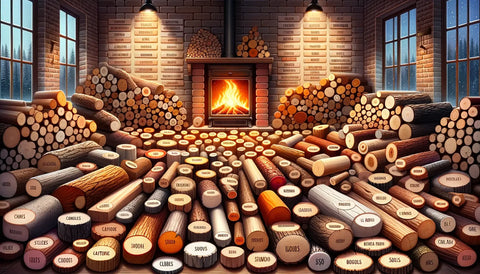
Hardwood or Softwood Blends
If you can’t decide between hardwood and softwood logs, mixed loads offer the best of both worlds:
- Hardwood logs provide long-lasting overnight heat.
- Softwood logs quickly light the fire.
- Combining the two balances out costs.
A 50/50 hardwood/softwood split gives a wood burner the flexibility to create short, hot fires or steady, lasting warmth. The mix of densities, burn speeds and heat outputs makes blended loads very versatile.
Top Species To Try
To summarise, here are some of the best log varieties to try in your wood burner:
Oak - Very dense, burns slow and hot. Gives great heat value over many hours. Adds a delightful smoky aroma.
Beech - Another dense hardwood that burns cleanly and steadily. Low sap and smoke. Provides intense heating power.
Ash - Superb firewood that’s easy to split. No sparks or spitting. Forms great bed of embers perfect for overnight burning.
Birch - Pleasantly scented and easy to light. Burns brightly but quickly. Use for fast warmth and fire starting.
Pine - Classic budget-friendly softwood. Lights easily and burns hot but fast. Use with harder woods for balance.
There are lots of excellent logs out there but these five are some of the most popular and pragmatic choices for British wood burners.
Avoid Problem Woods
While the woods above make great fuel, some types are best avoided. Problematic logs to steer clear of are:
- Elm - Hard to light, burns unpredictably, spits dangerously.
- Eucalyptus - Burns excessively hot, even exploding. Very high risk of damage.
- Willow - Causes chimney blockages with burnt powdery residue.
- Poplar - Makes loud popping noises and sparks. Risk of flue fires.
- Laburnum - Poisonous, gives off unpleasant smoke.
- Liquidambar - Smoky, acidic vapours that quickly corrode stoves and flues.
Save yourself the headache and potential safety issues by sticking to quality oak, ash, beech and other cleaner-burning woods.
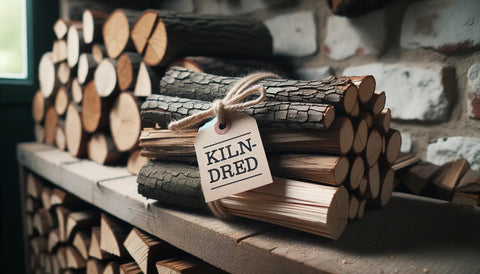
Premium Kiln-Dried Logs
For the best possible performance, premium kiln-dried logs are the ultimate option. Slow-dried for 6-8 weeks to below 20% moisture content, these logs have remarkable benefits:
- Huge 50% increase in usable heating power.
- Ability to burn immediately without seasoning.
- Low 15% moisture means more energy goes into warming.
- No bark or dirt residue. Cleaner glass doors.
- Reduced risk of flue blockages and chimney fires.
- Light instantly and burn efficiently.
- Greater environmental sustainability.
That unbeatable combination of efficiency, heat and convenience makes premium kiln-dried logs the gold standard firewood for discerning wood stove enthusiasts.
In Conclusion
Choosing the perfect logs may seem complicated but following this advice simplifies the process:
- Select hardwoods like oak, ash and beech for clean, long-lasting heat.
- Kiln drying provides much better efficiency and heat than green wood.
- Match log size to your stove’s firebox for optimal burning.
- Dense woods like ash and oak release more energy per log.
- Always keep logs dry right up until burning time.
- Buy from sustainable sources to benefit the environment.
- Seasoned or kiln-dried logs burn better than fresh 'green' wood.
- Blends combine advantages of both softwoods and hardwoods.
Taking these key tips into account when selecting firewood means you’ll choose logs tailored for superior performance in your specific wood burner. That translates to warmer, more comfortable and cost-effective heating all winter long.
FAQs about Choosing logs for wood burners
What are the signs of well-seasoned firewood?
- Cracks on the ends of the logs from drying out
- Dark brown color vs fresh pale wood
- No green leaves or needles attached
- No fungal growth if stored properly
- Light weight as internal moisture has evaporated
Why does wet firewood lead to chimney blockages?
Wet, unseasoned wood burns cooler and creates more smoke and creosote residue. This sticky buildup coats and clogs chimney flues over time. Burning dry wood produces less smoke and creosote.
How do different woods impact the flavor of food when cooking over a fire?
Dense hardwoods like oak and hickory give stronger, smokier flavors. Fruitwoods like apple and cherry impart milder sweetness. Softwoods like pine can make food taste resinous.
Can burning wood damage your stove or flue?
Yes, woods with high silica or acid content like willow and eucalyptus can damage stoves and flues. Always check suitability before burning unfamiliar logs.
What are the signs of damp firewood?
- White/blue mold spots
- Musty smell
- Green algae growth
- Weighs more than seasoned wood
Why should loose bark be removed from logs?
It can float up the flue and block it. Bark also spits dangerously when burning. Debarked logs burn cleaner and more safely.
How long do hardwood logs need to air dry?
2 years is optimal for dense hardwoods like oak and beech to season properly. Softwoods may only need 6-12 months. Kiln drying accelerates this.
What are the advantages of split logs vs whole round logs?
Split logs dry out faster as more cut surfaces are exposed. Their shape packs better in stoves for more efficient burning. Round logs take longer to season but provide very long burn times.
Should I store logs in my house to help them dry before burning?
No, it's better to store them in a covered woodshed or garage. Logs can harbor insects and mold spores that you don't want inside your home.
What are signs that firewood is too wet to burn properly?
Difficulty lighting, sizzling/hissing sounds, excessive smoke, black tar dripping from log ends, creosote buildup in chimney.
How can I test the moisture level of my firewood?
Use a moisture meter designed for wood. Optimal levels are below 20% moisture content. Anything over 25% is too wet for efficient burning.
What are the benefits of buying firewood in spring/summer vs fall/winter?
Wood bought early in the year has more time to dry out fully before you need to burn it when the weather turns cold.
Should I burn scrap construction wood and pallets?
Avoid as they may contain nails, glue and paint that can release toxic fumes and damage your stove when burned.
Can I use wood from tree surgeons to heat my stove?
Yes, this waste wood is usable if from safe species. Ensure it's well seasoned as freshly cut green wood burns poorly.
What are good dense firewoods for heating besides oak and beech?
Ash, elm, black locust, osage orange, hickory, and hard maple all have excellent density and heat value.
Is it okay to burn logs with fungus growing on them?
No, fungal spores can be harmful if inhaled. Never burn moldy rotten logs. Prime logs should have no fungus.
How can I start a fire if my logs are damp?
Use extra kindling and completely dry wood as the base. Having some kiln-dried logs helps enormously with lighting.
What moisture indicators show logs are ready to burn?
Cracked ends, hollow sounds when struck together, lightweight, darkened color, easily ignited with a match.


